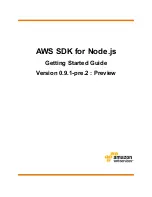
The Response Object (
AWS.Response
)
The response object is passed into each callback function so that you can access response data. The
AWS.Response
object that is passed in contains two important properties to get at this data:
•
data
•
error
When using the standard callback mechanism, the two properties will be made available as parameters
on the callback method in the form:
function(error, data) { ... }
The
data
property
The
response.data
property contains the serialized object data retrieved from the service request. For
instance, for an Amazon DynamoDB
listTables
method call, the response data might look like this:
> response.data
{ TableNames:
[ 'table1', 'table2', ... ] }
The
data
property can be null if an error occurs (see below).
The
error
property
In the event of a service error (or transfer error), the
response.error
property will be filled with the
given error data in the form:
{ code: 'SHORT_UNIQUE_ERROR_CODE',
message: 'Some human readable error message' }
In the case of an error, the
data
property will be null. Note that if you handle events that can be in a
failure state, you should always check whether
response.error
is set before attempting to access the
response.data
property.
The
request
Property
Access to the originating request object is available through this property. For example, to access the
parameters that were sent with a request:
s3.getObject({Bucket: 'bucket', Key: 'key'}).on('success', function(response)
{
console.log("Key was", response.request.params.Key);
}).send();
Version 0.9.1-pre.2 : Preview
10
AWS SDK for Node.js Getting Started Guide
The Response Object (
AWS.Response
)





































